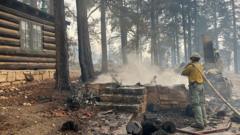The devastating Dragon Bravo Fire has wreaked havoc near the Grand Canyon, obliterating the historic Grand Canyon Lodge along with a significant number of structures. This lodge, which had been the sole accommodation on the North Rim of the iconic national park, succumbed to the flames amid the ongoing wildfires sweeping across thousands of acres in the region.
The inferno that took the Grand Canyon Lodge started on July 4 and is categorized among the two principal fires—Dragon Bravo and the White Sage Fire—that are currently ravaging Arizona's North Rim. As of the latest reports, both fires remain at 0% containment, leading to the closure of the North Rim for the entire 2025 tourist season.
Located at an elevation of approximately 8,000 feet (2,438 meters), the Grand Canyon Lodge was a hub for visitors, housing dining facilities, a gift shop, and a post office, having served guests since the 1930s. Aramark, the lodge's operating company, expressed its devastation over the loss while confirming that all employees and guests were safely evacuated before the fire intensified.
While no injuries have been reported, preliminary assessments from the National Park Service (NPS) indicate that the Dragon Bravo Fire has claimed between 50 and 80 structures, including essential administrative buildings and visitor services. Compounding the danger, firefighters had to evacuate from some areas due to a chlorine leak from a nearby water treatment facility, presenting hazardous conditions as chlorine gas can settle in lower regions.
Arizona's Governor Katie Hobbs has publicly thanked first responders but has also raised concerns over federal response strategies, arguing for an investigation after the fire began with a lightning strike and was managed as a controlled burn during extreme weather conditions. "Intense oversight and scrutiny" was called for, according to Hobbs’ statements on social media.
Elizabeth Peace, representing the US Interior Department, countered these claims, asserting that the management of the fire is being handled with the utmost seriousness and that there is a clear distinction between a controlled burn and a wildfire.
In the meantime, the unfaltering spread of the White Sage Fire has engulfed over 40,000 acres within the Kaibab National Forest, leading to the urgent evacuation of hundreds of residents. With nearly five million visitors frequenting the Grand Canyon in 2024, the impact on tourism is imminent, especially as only the South Rim of the canyon remains open amid the chaos of ongoing wildfires.
The inferno that took the Grand Canyon Lodge started on July 4 and is categorized among the two principal fires—Dragon Bravo and the White Sage Fire—that are currently ravaging Arizona's North Rim. As of the latest reports, both fires remain at 0% containment, leading to the closure of the North Rim for the entire 2025 tourist season.
Located at an elevation of approximately 8,000 feet (2,438 meters), the Grand Canyon Lodge was a hub for visitors, housing dining facilities, a gift shop, and a post office, having served guests since the 1930s. Aramark, the lodge's operating company, expressed its devastation over the loss while confirming that all employees and guests were safely evacuated before the fire intensified.
While no injuries have been reported, preliminary assessments from the National Park Service (NPS) indicate that the Dragon Bravo Fire has claimed between 50 and 80 structures, including essential administrative buildings and visitor services. Compounding the danger, firefighters had to evacuate from some areas due to a chlorine leak from a nearby water treatment facility, presenting hazardous conditions as chlorine gas can settle in lower regions.
Arizona's Governor Katie Hobbs has publicly thanked first responders but has also raised concerns over federal response strategies, arguing for an investigation after the fire began with a lightning strike and was managed as a controlled burn during extreme weather conditions. "Intense oversight and scrutiny" was called for, according to Hobbs’ statements on social media.
Elizabeth Peace, representing the US Interior Department, countered these claims, asserting that the management of the fire is being handled with the utmost seriousness and that there is a clear distinction between a controlled burn and a wildfire.
In the meantime, the unfaltering spread of the White Sage Fire has engulfed over 40,000 acres within the Kaibab National Forest, leading to the urgent evacuation of hundreds of residents. With nearly five million visitors frequenting the Grand Canyon in 2024, the impact on tourism is imminent, especially as only the South Rim of the canyon remains open amid the chaos of ongoing wildfires.























